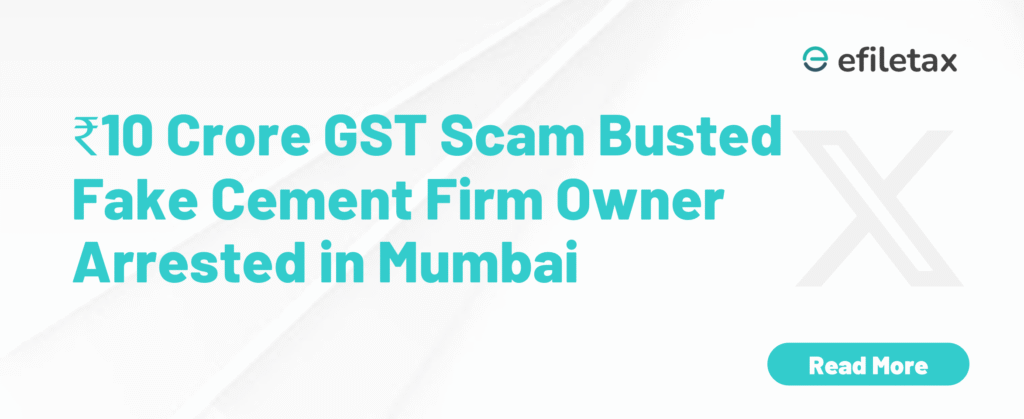
GST Input Tax Credit Fraud in Mumbai: ₹10 Cr Scam Busted
A shocking case of GST input tax credit fraud has emerged from Mumbai, where the owner of a fake cement trading firm was arrested for availing ₹10 crore in fraudulent ITC without actual supply of goods. As per DGGI sources, the accused floated shell companies and issued bogus invoices to claim tax credits, deceiving the government and violating GST law.
Let’s break down how such scams operate, what the law says, and how you can protect your business.
What is GST Input Tax Credit (ITC)?
Input Tax Credit (ITC) allows businesses to reduce the tax they pay on outputs by claiming credit for the tax paid on purchases. Under Section 16 of the CGST Act, 2017, a registered person can avail ITC only if:
- They possess a tax invoice
- Goods/services are received
- The supplier has paid tax to the government
- The return (GSTR-3B) has been filed
How Did the ₹10 Crore ITC Scam Work?
According to DGGI (Directorate General of GST Intelligence), the accused:
- Created fake GST-registered entities
- Issued bogus invoices for cement trade
- Claimed ITC without any physical supply
- Transferred fake credits across entities to cash out
This violates Section 132 of CGST Act, which deals with offences like:
- Availing ITC without invoice or actual supply
- Issuing invoices without supply
- Fraudulently obtaining refunds or credits
Under this section, offences involving more than ₹5 crore are non-bailable and can lead to 5 years of imprisonment.
Legal Penalties Under GST Law
Here’s a quick table of applicable penalties for such frauds:
| Offence | Section | Penalty |
|---|---|---|
| Fake ITC > ₹5 crore | Sec 132(1) | Imprisonment up to 5 years |
| Availing ITC without supply | Sec 132(1)(c) | Non-bailable offence |
| Aiding in fraud (CA, accountant) | Sec 132(1)(f) | Same punishment as offender |
| Provisional attachment of assets | Sec 83 | Bank a/c and property can be frozen |
Source: CGST Act, 2017 and CBIC guidelines
Expert View: How to Stay Compliant and Safe
CA Rajeev Jain, an indirect tax expert, advises:
“Always match your purchase ITC with GSTR-2B. Do not claim ITC unless the vendor has filed returns and paid tax. Use compliance tools or GSP partners like Efiletax to monitor your vendor network regularly.”
What Should Businesses Do?
- Check GSTR-2B before availing ITC
- Use GSTIN Verification tools for new vendors
- Avoid dealing with fly-by-night operators
- Conduct regular GST health checks of your books
- File GSTR-1 and GSTR-3B on time to avoid mismatch
- In case of doubt, report suspicious invoices to CBIC via www.cbic.gov.in
How Efiletax Helps You Stay GST Compliant
At Efiletax, we offer:
- Automated GSTR-2B matching tools
- GSTIN verification and risk alerts
- GSTR-1/3B filing services with accuracy
- Professional guidance to avoid legal pitfalls
Stay compliant. Avoid penalties. Book a GST check-up with Efiletax today.
FAQs on GST ITC Fraud
Q1. What is fake ITC in GST?
Claiming input tax credit without actual supply of goods or services, often using bogus invoices.
Q2. Is it a criminal offence?
Yes. If fake ITC exceeds ₹5 crore, it becomes a non-bailable offence under Section 132 of CGST Act.
Q3. Can I be punished if I unknowingly deal with a fake supplier?
Yes, ITC will be denied if the supplier hasn’t paid tax or filed returns. Due diligence is your responsibility.
Q4. How to verify vendors before dealing?
Check their GST return filing history on GSTN, use GSTR-2B, or partner with compliance experts like Efiletax.
Summary
Learn how ITC scams work, what penalties apply under CGST Act, and how businesses can stay GST compliant with tools like GSTR-2B and Efiletax.